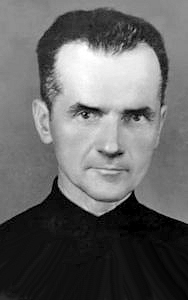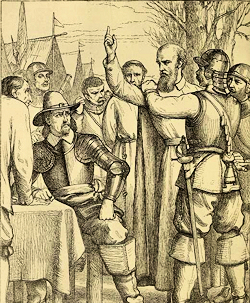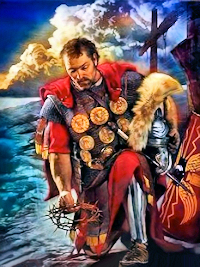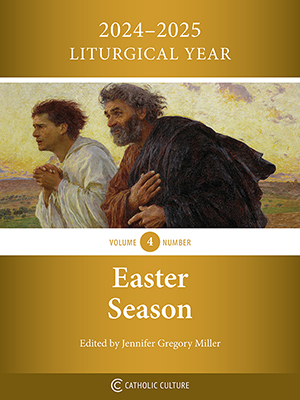Ordinary Time: October 30th
Friday of the Thirtieth Week in Ordinary Time
» Enjoy our Liturgical Seasons series of e-books!
Historically today is the feast of St. Alphonsus Rodriguez of Segovia, Spain. He was the third child to a wool merchant. He had originally begun to study to be a Jesuit from age 14, but when he father died he was obligated to take over the family business at age 23. He married and had children, but on the death of his wife and children, he lost his shop and experienced misfortune. He prayed and was inspired to become a Jesuit at age 40. He was found too old to study for the priesthood and too weak to take up a lay brother’s work but the Provincial boldly admitted him, remarking that he was receiving him for his holiness. He proved right. A little while after his first vows he was appointed porter or door-keeper of the Jesuit college at Majorca and for the next forty years he remained at the same post. It was patient humble work for hours on end, daily walking up and down, taking messages of visitors and students and distributing alms to the poor. He was an influence for good to the hundreds who met him. He spent his time in quiet prayer and meditation, and towards the end he lost even his memory and could only say, “Jesus, Mary”. On October 31, 1617, surrounded by his Jesuit brothers he died.
St. Marcellus
It is believed that St. Marcellus was born in Arzas of Galicia. A brave pagan, he entered the military, hoping to gain a large fortune. He married a young lady named Nona and they were blessed with twelve children. Saint Marcellus was a valorous soldier and was promoted to the charge of centurion; he had no thought for any advancement except the sort pertaining to his military life when he heard the fervent preaching of a holy bishop of the church of Leon. He was converted with his entire family to the Christian religion. All of them except his wife would soon give their blood in honor of their Faith.
The birthday of Emperor Maximian Herculeus was celebrated in the year 298 with extraordinary feasting and solemn rites. Marcellus, as a centurion of the army, a captain in the legion of Trajan then posted in Mauritania or Spain, in order not to defile himself in these impious sacrifices, left his company, throwing down his cincture and his arms and declaring aloud that he was a soldier of Jesus Christ, the eternal King. He was at once committed to prison. When the festival was over, he was brought before a judge, and having reiterated his faith, was sent under a strong guard to a prefect, Aurelian Agricolaus. This Roman officer passed upon him a sentence of death by the sword. Marcellus was immediately led to execution and beheaded on the 30th of October of the year 298. Cassian, the secretary or notary of the court, refused to record the sentence pronounced against the martyr, because of its injustice. He was immediately taken to prison and was beheaded in his turn on the 3rd of December.
The children of Saint Marcellus imitated his constancy, and all lost their lives for the defense of the Gospel; three of the boys were hanged and then decapitated at Leon. Their pious mother bought back their bodies for money and buried them secretly; they were later transferred to a church built in their honor in the city of Leon.
—Les Petits Bollandistes: Vies des Saints, by Msgr. Paul Guérin (Bloud et Barral: Paris, 1882), Vol. 13; Little Pictorial Lives of the Saints, a compilation based on Butler's Lives of the Saints and other sources by John Gilmary Shea (Benziger Brothers: New York, 1894).
Patronage: conscientious objectors; city of León, Spain; Province of León, Spain
Highlights and Things To Do:
- Read more about St. Marcellus:
- St. Marcellus' relics were later brought to and enshrined at the Church of San Marcelo in León, Spain (dating from the 10th century), and he became a patron saint of the city. The Plaza de San Marcelo in this city is named for him.
Bl. Oleksa Zarytsky
 He was born in Lviv (Western Ukraine) in 1912, the son of a Catholic family. He has only one desire in his heart, the very young Alessio: to become a priest. He grows up and studies, aiming resolutely at the goal: the holy altar. In the cathedral of his city, in 1936, at the age of 24, he was ordained a priest.
He was born in Lviv (Western Ukraine) in 1912, the son of a Catholic family. He has only one desire in his heart, the very young Alessio: to become a priest. He grows up and studies, aiming resolutely at the goal: the holy altar. In the cathedral of his city, in 1936, at the age of 24, he was ordained a priest.
It was a terrible time: Stalin was turning Russia and Eastern Europe up to Siberia into an immense prison, where Catholics are the first to be persecuted, and priests, considered dangerous for the communist regime, must be the first to disappear.
Fr. Alessio was truly in love with Jesus and out of love for Him he nourished an intense spirit of apostolic activity, an untiring zeal for souls, and an unlimited dedication to his ministry. He was always available, without ever thinking of himself, with a mild disposition that brought everyone together, a singular understanding for people: the true style of the good shepherd.
In his diocese some communities were entrusted to him: they were persecuted but never demolished. His first concern, even knowing he risked prison and his life, was that everyone can go to confession and often receive the Eucharist. He existed like this for eleven years. The police of the atheist and murderous communist regime kept an eye on him and hunted him down, he was almost a brigand!
In 1948, as a parish priest in Ukraine, he was arrested because of his fidelity to the Catholic Church. The Communist authorities proposed that he become an Orthodox bishop, separating himself from the Pope of Rome and thus he would have had an easier life. Fr Alessio refused harshly: "To separate myself from the Pope — he declared — is to betray the Gospel of Christ!".
With Stalin's death, in March 1953, and then in 1956, following the 20th Congress of the CPSU, the iron grip of the Communist dictatorship seemed to loosen which intended to annihilate the Catholic church. Fr. Alessio was released from prison and immediately resumed his apostolate at an enormous risk as the police always kept an eye on him
Before the end of 1956, while Khrushchev invaded Hungary with tanks and crushed it in blood, Fr. Alessio Zarytsky was forced into exile in Karaganda in Kazakhstan. He was welcomed by all as Jesus in person and the faithful soon call him "God's vagabond". In fact, he undertook pastoral journeys of thousands of kilometers through Kazakhstan, nine times the size of Italy. To visit the Catholics, he went as far as Siberia.
In 1957, he was secretly appointed apostolic administrator for Kazakhstan and Central Asia by the Ukrainian Metropolitan Archbishop Josyf Slipyi (1984), a future Cardinal, who for 20 years suffered the unspeakable in the gulags of Siberia. On his long journeys, Fr. Alessio stopped where he knew that there were communities of Catholics to administer the sacraments to various families even in the most remote villages. In the same years, he went several times to those German Catholics who from the lands of the Volga and the Black Sea had been deported by Stalin to the Urals and interned in poor barracks.
Once again, he resumed his apostolate as an itinerant priest, with no fixed abode, turning above all to Kazakhstan.
In April 1962, Fr. Alessio was arrested by the secret police and placed in the Dolinka concentration camp near Karaganda, where he was nearing his end amidst terrible suffering. After much ill-treatment and humiliation, Fr. Alessio obtained the palm of martyrdom "ex aerumnis carceris" (= for the tortures in prison), on October 13, 1963.
On May 27, 2001, Pope John Paul II beatified Fr. Alessio Zarytsky in Lviv. In 2007, Archbishop Schneider consecrated the first church in Karanganda in honor of Blessed Alessio, also wearing the surplice that belonged to him and was given to him by his brother Ivan Zarytsky, who is still alive.
—Excerpted from Santi Beati
Highlights and Things To Do:
- Learn more about Fr. Alessio Zarytsky:
Bl. Terence Albert O'Brien
 Terence Albert O’Brien was born in Limerick in 1601 near Cappamore, that time in the diocese of Emly. Both his Mother and Father were from the noble family of O’Brien Arra and has a vast estate of 2000 acres.
Terence Albert O’Brien was born in Limerick in 1601 near Cappamore, that time in the diocese of Emly. Both his Mother and Father were from the noble family of O’Brien Arra and has a vast estate of 2000 acres.
He joined the Dominicans, receiving the name Albert at Limerick, where his uncle, Maurice O'Brien, was then prior. In 1622 he studied at Toledo and after eight years returned to Limerick, to become twice prior there and once at Lorrha, and in 1643 provincial of his order in Ireland. His services to the Catholic Confederation were highly valued by the Supreme Council. At Rome, he received the degree of Master in Theology, and on his return made a visitation of two houses of his province at Lisbon, where it was reported that Urban VIII was about to appoint him coadjutor to the Bishop of Emly. He was again named for the coadjutorship by the Supreme Council at the end of 1645 and recommended by the nuncio Rinuccini. Subsequently, at the petition of many bishops, Rinuccini wrote (17 March 1646) that Burgat, Vicar-General of Emly, was a suitable person for the coadjutorship. In August he renewed his recommendation of Father Terence O'Brien, who was named coadjutor with the right of succession, in March 1647, and eight months later was consecrated bishop by Rinuccini. He was to be the last Bishop of the Diocese of Emly.
Throughout the ensuing troubles he adhered to the nuncio. He signed the declaration against Inchiquin's truce in 1648, and the declaration against Ormond in 1650. When Limerick was besieged in 1651, he urged a stubborn resistance and so embittered the Ormondists and the Parliamentarians, that in the capitulation he was excluded from quarter and protection.
For the next two years he dedicated himself to supporting and consoling his flock grievously harried by the armies of Cromwell in a period of intense persecution of the Catholic faith in Ireland. As the full force of Cromwellian persecution was unleashed upon the country, he took his place at the center of the resistance to Cromwell’s armies in Limerick City, which was soon to be sieged by Cromwell’s deputy; General Henry Ireton.
Limerick surrendered on October 27, 1651, after a 5-month siege in which Bishop O’Brien urged resistance while treating the wounded and supporting the soldiers and civilians throughout the siege. He was one of those that were refused pardon by the English because of the principal part he played in the stubborn refusal of the people of Limerick to surrender.
He made no attempt to escape and was captured on October 30, 1651. He was brought before a court-martial setup up by Ireton (commander of English forces besieging Limerick) and sentenced to death and was accordingly executed on October 31st. It is said he faced his death with serenity and joy and from the scaffold where he was to be executed on the Hill of Cluain, he prayed for the throng of people gathered around and asked of them to preserve the Faith, keep the Commandments, and be resigned to the Will of God. Eyewitness accounts tell of how the English soldiers hacked and beat his body for 3 hours until it lost all human resemblance. His head was severed and placed on a spike over the City Walls.
General Ireton who ordered his court martial and death would die of the plague within 3 weeks of Blessed O’Brien’s execution. Eyewitness accounts of his tormented death tell of him haunted by remorse and acknowledging that the innocent blood of the Bishop was the cause of his own death.
He was consecrated Bishop of Emly on April 2, 1648 and was to be the last Bishop of the Diocese of Emly.
—Excerpted from the Emly Historical Society
Highlights and Things To Do:
- Learn more about Bl. Terence Albert O'Brien:






